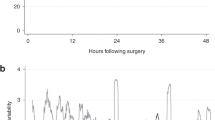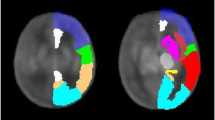Abstract
Objective:
To characterize and investigate the relationship between systemic blood flow and pre- and postoperative cerebral electrical activity in preterm neonates undergoing patent ductus arteriosus (PDA) ligation.
Study design:
A prospective observational study was conducted in 17 preterm neonates undergoing PDA ligation. All infants had amplitude-integrated electroencephalography (aEEG) recorded continuously from 4 h preoperatively to 24 h postoperatively. Targeted neonatal echocardiography was performed to evaluate myocardial performance and systemic blood flow at four sequential time points: preoperatively; 1, 8 and 24 h postoperatively.
Result:
PDA ligation was followed by a fall in the lower border of the aEEG trace lower left ventricular output, but recovery of diastolic flow in the middle cerebral artery. Altered lower margin was associated with gestational age and PDA diameter on univariate analysis, but not with low cardiac output.
Conclusion:
PDA ligation was associated with altered cerebral electrical activity, although these changes were not related to low cardiac output state.
This is a preview of subscription content, access via your institution
Access options
Subscribe to this journal
Receive 12 print issues and online access
$259.00 per year
only $21.58 per issue
Buy this article
- Purchase on SpringerLink
- Instant access to full article PDF
Prices may be subject to local taxes which are calculated during checkout


Similar content being viewed by others
References
Van Overmeire B, Chemtob S . The pharmacologic closure of the patent ductus arteriosus. Semin Fetal Neonatal Med 2005; 10 (2): 177–184.
Jain A, Sahni M, El-Khuffash A, Khadawardi E, Sehgal A, McNamara PJ . Use of targeted neonatal echocardiography to prevent postoperative cardiorespiratory instability after patent ductus arteriosus ligation. J Pediatr 2012; 160 (4): 584.
Chorne N, Leonard C, Piecuch R, Clyman RI . Patent ductus arteriosus and its treatment as risk factors for neonatal and neurodevelopmental morbidity. Pediatrics 2007; 119 (6): 1165–1174.
Kabra NS, Schmidt B, Roberts RS, Doyle LW, Papile L, Fanaroff A . Neurosensory impairment after surgical closure of patent ductus arteriosus in extremely low birth weight infants: results from the trial of indomethacin prophylaxis in preterms. J Pediatr 2007; 150 (3): 229–234.
El-Khuffash AF, McNamara PJ . Neonatologist-performed functional echocardiography in the neonatal intensive care unit. Semin Fetal Neonatal Med 2011; 16 (1): 50–60.
Lemmers PM, Molenschot MC, Evens J, Toet MC, van Bel F . Is cerebral oxygen supply compromised in preterm infants undergoing surgical closure for patent ductus arteriosus? Arch Dis Child Fetal Neonatal Ed 2010; 95 (6): F429–F434.
Teixeira LS, Shivananda SP, Stephens D, Van Arsdell G, McNamara PJ . Postoperative cardiorespiratory instability following ligation of the preterm ductus arteriosus is related to early need for intervention. J Perinatol 2008; 28 (12): 803–810.
Sun L . Early childhood general anaesthesia exposure and neurocognitive development. Br J Anaesth 2010; 105 (Suppl 1): i61–i68.
McCann ME, Soriano SG . Perioperative central nervous system injury in neonates. Br J Anaesth 2012; 109 (Suppl 1): i60–i67.
Mertens L, Seri I, Marek J, Arlettaz R, Barker P, McNamara P et al. Targeted neonatal echocardiography in the neonatal intensive care unit: practice guidelines and recommendations for training. Writing group of the American Society of Echocardiography (ASE) in collaboration with the European Association of Echocardiography (EAE) and the Association for European Pediatric Cardiologists (AEPC). J Am Soc Echocardiogr 2011; 24 (10): 1057–1078.
Stevens B, Johnston C, Petryshen P, Taddio A . Premature infant pain profile: development and initial validation. Clin J Pain 1996; 12 (1): 13–22.
Systolic blood pressure in babies of less than 32 weeks gestation in the first year of life. Northern Neonatal Nursing Initiative. Arch Dis Child Fetal Neonatal Ed 1999; 80 (1): F38–F42.
Hellstrom-Westas L, Rosen I . Continuous brain-function monitoring: state of the art in clinical practice. Semin Fetal Neonatal Med 2006; 11 (6): 503–511.
Bland JM, Altman DG . Multiple significance tests: the Bonferroni method. BMJ 1995; 310 (6973): 170.
Spitzmiller RE, Phillips T, Meinzen-Derr J, Hoath SB . Amplitude-integrated EEG is useful in predicting neurodevelopmental outcome in full-term infants with hypoxic-ischemic encephalopathy: a meta-analysis. J Child Neurol 2007; 22 (9): 1069–1078.
al Naqeeb N, Edwards AD, Cowan FM, Azzopardi D . Assessment of neonatal encephalopathy by amplitude-integrated electroencephalography. Pediatrics 1999; 103 (6 Pt 1): 1263–1271.
Thornberg E, Ekstrom-Jodal B . Cerebral function monitoring: a method of predicting outcome in term neonates after severe perinatal asphyxia. Acta Paediatr 1994; 83 (6): 596–601.
Toet MC, Hellstrom-Westas L, Groenendaal F, Eken P, de Vries LS . Amplitude integrated EEG 3 and 6 hours after birth in full term neonates with hypoxic-ischaemic encephalopathy. Arch Dis Child Fetal Neonatal Ed 1999; 81 (1): F19–F23.
Klebermass K, Olischar M, Waldhoer T, Fuiko R, Pollak A, Weninger M et al. Amplitude-integrated EEG pattern predicts further outcome in preterm infants. Pediatr Res 70 (1): 102–108.
Watanabe K, Hayakawa F, Okumura A . Neonatal EEG: a powerful tool in the assessment of brain damage in preterm infants. Brain Dev 1999; 21 (6): 361–372.
McNamara PJ, Stewart L, Shivananda SP, Stephens D, Sehgal A . Patent ductus arteriosus ligation is associated with impaired left ventricular systolic performance in premature infants weighing less than 1000 g. J Thorac Cardiovasc Surg 2010; 140 (1): 150–157.
Haigh PM, Chiswick ML, O'Donoghue EP . Retinopathy of prematurity: systemic complications associated with different anaesthetic techniques at treatment. Br J Ophthalmol 1997; 81 (4): 283–287.
Bernet V, Latal B, Natalucci G, Doell C, Ziegler A, Wohlrab G . Effect of sedation and analgesia on postoperative amplitude-integrated EEG in newborn cardiac patients. Pediatr Res 2010; 67 (6): 650–655.
Bell AH, Greisen G, Pryds O . Comparison of the effects of phenobarbitone and morphine administration on EEG activity in preterm babies. Acta Paediatr 1993; 82 (1): 35–39.
Kofke WA, Garman RH, Stiller RL, Rose ME, Garman R . Opioid neurotoxicity: fentanyl dose-response effects in rats. Anesth Analg 1996; 83 (6): 1298–1306.
Loepke AW . Developmental neurotoxicity of sedatives and anesthetics: a concern for neonatal and pediatric critical care medicine? Pediatr Crit Care Med 2010; 11 (2): 217–226.
Martin CG, Snider AR, Katz SM, Peabody JL, Brady JP . Abnormal cerebral blood flow patterns in preterm infants with a large patent ductus arteriosus. J Pediatr 1982; 101 (4): 587–593.
Lipman B, Serwer GA, Brazy JE . Abnormal cerebral hemodynamics in preterm infants with patent ductus arteriosus. Pediatrics 1982; 69 (6): 778–781.
Noori S, Friedlich P, Seri I, Wong P . Changes in myocardial function and hemodynamics after ligation of the ductus arteriosus in preterm infants. J Pediatr 2007; 150 (6): 597–602.
Author information
Authors and Affiliations
Corresponding author
Ethics declarations
Competing interests
The Olympic CFM 6000 Monitor was donated by Natus Medical (San Carlos, CA, USA).
Rights and permissions
About this article
Cite this article
Leslie, A., Jain, A., EL-Khuffash, A. et al. Evaluation of cerebral electrical activity and cardiac output after patent ductus arteriosus ligation in preterm infants. J Perinatol 33, 861–866 (2013). https://doi.org/10.1038/jp.2013.85
Received:
Revised:
Accepted:
Published:
Issue Date:
DOI: https://doi.org/10.1038/jp.2013.85
Keywords
This article is cited by
-
The impact of a dedicated patent ductus arteriosus ligation team on neonatal health-care outcomes
Journal of Perinatology (2016)



